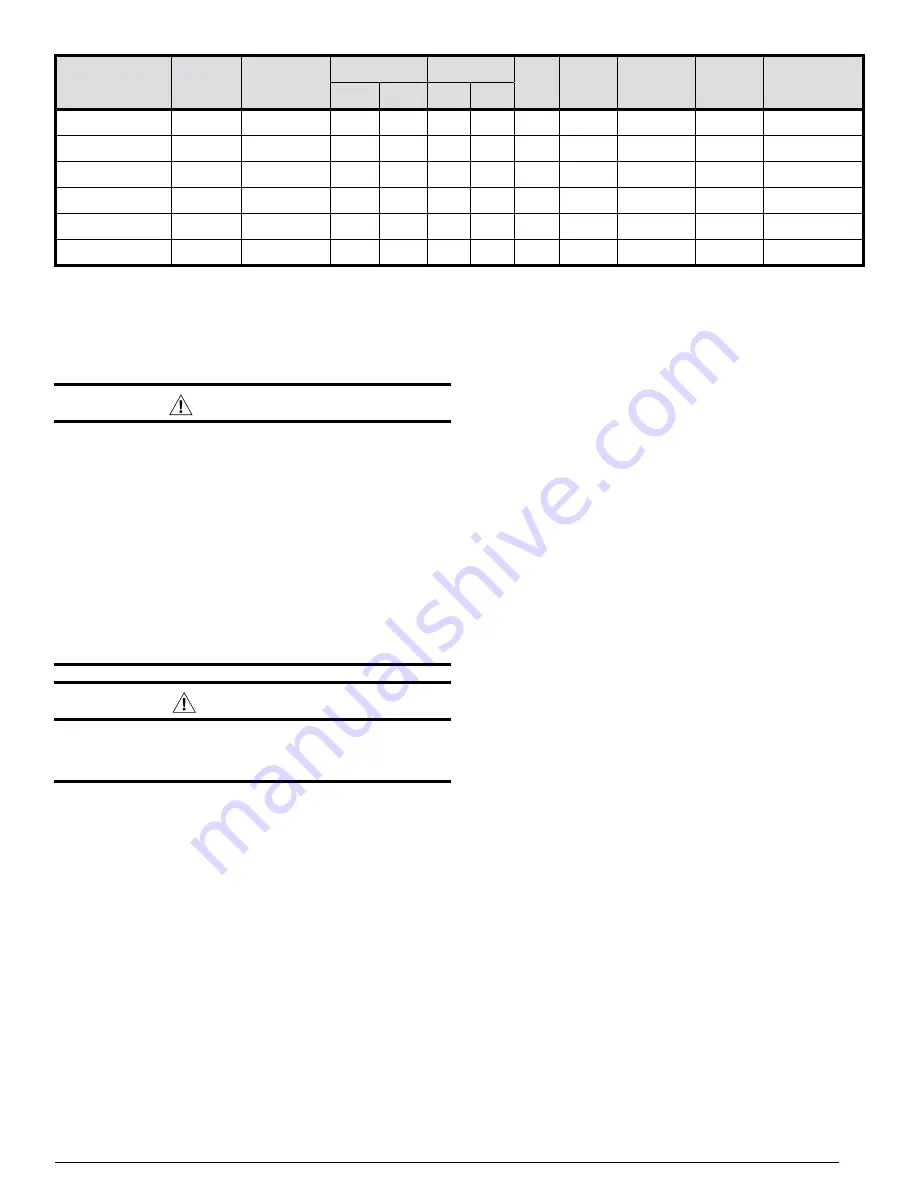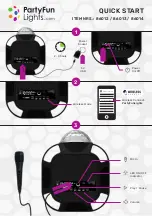
25
Table 9. Electrical Data.
MODEL
NUMBER
HEATING
INPUT
(BTUH)
NOMINAL
ELECTRICAL
SUPPLY
VOLTAGE RANGE COMPRESSOR
FAN
AMPS
BLOWER
MOTOR
AMPS
INDUCER
MOTOR
AMPS
MINIMUM
CIRCUIT
AMPACITY
MAXIMUM
OVER-CURRENT
PROTECTION
MIN.
MAX.
RLA
LRA
4YCL4024A1055A
55,000
230-60-1
196
253
12.8
58.3
1.0
3.8
0.7
20.8
30
4YCL4030A1070A
70,000
230-60-1
196
253
15.7
73
1.46
5.4
0.7
26.5
40
4YCL4036A1070A
70,000
230-60-1
196
253
18.6
79
1.46
5.4
0.7
30.1
45
4YCL4042A1100A
100,000
230-60-1
196
253
22.1
109
1.46
5.4
0.7
34.5
50
4YCL4048A1100A
100,000
230-60-1
196
253
24.3
117
1.46
5.4
0.7
37.2
60
4YCL4060A1100A
100,000
230-60-1
196
253
29.3
134
1.46
7.0
0.7
45.2
70
NOTE:
FLA = Full Load Amps; LRA = Lock Rotor amps; RLA = Rated Load Amps.
REFRIGERANT CHARGING
WARNING:
These units are shipped fully charged with R-410A
refrigerant and ready for installation. When a system
is installed according to these instructions, no
refrigerant charging is required. If repairs make it
necessary for evacuation and charging, it should
only be done by qualified, trained personnel
thoroughly familiar with this equipment. Some
local codes require licensed installation/service
personnel to service this type of equipment. Under
no circumstances should the owner attempt to install
and/or service this equipment. Failure to comply
with this warning could result in property damage,
personal injury, or death.
CAUTION:
This unit uses R-410A refrigerant. DO NOT use any
other refrigerant in this unit. Use of another refrigerant
may damage the unit.
The system refrigerant charge can be checked and adjusted
through the service ports provided at the front panel. Use
only gauge lines which have a “Schrader” depression device
present to actuate the valve. Draw a vacuum on gauge lines
to remove air before attaching them to the service ports on the
unit. Refrigerant charging must be done by qualified personnel
familiar with safe and environmentally responsible refrigerant
handling procedures.
Application Notes & Charging Charts
(Cooling Mode Only)
This equipments cooling system contains refrigerant under
high pressure, always use safe practices when servicing the
unit. Always review the factory literature and safety warnings
prior to servicing.
These units are shipped from the factory with the proper
amount and type of refrigerant. Always inspect the unit rating
label to determine the units information prior to working on the
system. Do not mix different refrigerants or charge the unit
with a refrigerant not listed on the unit rating label.
The charging tables are valid for a variety of indoor, return
air conditions and are most highly influenced by the outdoor
ambient temperature, outdoor fan operation and the unit
operating voltage. Before referencing the charts, always make
sure that the compressor circuit is energized on nominal speed
(
Y1
energized) and has stable operation. As can be seen in
the charging charts, the ideal system sub-cooling can vary
over the range of operation. Always reference the charts to
determine the ideal amount of sub-cooling for a given liquid
pressure. Units charged to other values will not perform at the
rated unit efficiency (EER). For 2 - 4 ton units, see
, &
. For 5 ton units
To inspect a systems operation, using quality instruments,
match the measured liquid temperature to the units chart.
The measured liquid pressure reading should be within 3%
of the value shown for most installations.
For systems that are operating with more then a 5% deviation,
inspect the unit for leaks. Always use safe and environmentally
sound methods for refrigerant handling. When repairing system
leakages, always utilize a nitrogen (inert) gas to protect the
refrigerant system and pressure check the repair before re-
charging. Always replace the filter-dryers when performing
any repair to the refrigeration system. After completing the
repairs, evacuate the system to 350-500 microns and weigh in
the refrigerant to the amount specified on the unit rating label.








































